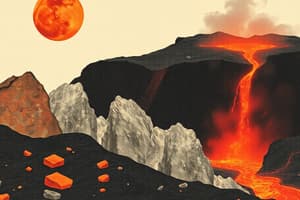Podcast
Questions and Answers
Define Concordant.
Define Concordant.
Parallel to the grain or layering of the surrounding rock.
Define Magma.
Define Magma.
Molten rock material that originates deep within the earth.
Define Igneous Rock.
Define Igneous Rock.
A type of rock formed from a molten material that has cooled and solidified.
Define Lava.
Define Lava.
How old is the Earth?
How old is the Earth?
What was the first type of rocks to form?
What was the first type of rocks to form?
______ Earth's crust is composed of igneous rocks.
______ Earth's crust is composed of igneous rocks.
Igneous rocks can be divided into two basic categories.
Igneous rocks can be divided into two basic categories.
Describe extrusive igneous rocks.
Describe extrusive igneous rocks.
Describe intrusive igneous rocks.
Describe intrusive igneous rocks.
How are Igneous Rocks classified?
How are Igneous Rocks classified?
Define Texture.
Define Texture.
Describe Aphanitic.
Describe Aphanitic.
Describe Glassy.
Describe Glassy.
Describe Porphyritic.
Describe Porphyritic.
Describe Pegmatitic.
Describe Pegmatitic.
Describe Phaneritic.
Describe Phaneritic.
What is the correlation of Mineral Composition and Color of Igneous Rocks?
What is the correlation of Mineral Composition and Color of Igneous Rocks?
What are oceanic plates composed of?
What are oceanic plates composed of?
What is the correlation between Density and Composition?
What is the correlation between Density and Composition?
What are continental plates composed of?
What are continental plates composed of?
Know the Common Igneous Rocks and how they are Organized by Composition.
Know the Common Igneous Rocks and how they are Organized by Composition.
Describe in detail Bowen's Reaction Series. Why is it important?
Describe in detail Bowen's Reaction Series. Why is it important?
Define Discordant.
Define Discordant.
How are Igneous rock bodies subdivided?
How are Igneous rock bodies subdivided?
Define Pluton. How are they classified?
Define Pluton. How are they classified?
Flashcards are hidden until you start studying
Study Notes
Key Definitions
- Concordant: Describes rock layers that run parallel to the surrounding geological features.
- Magma: Molten rock material located deep within the Earth.
- Lava: Magma that reaches the Earth's surface through volcanic activity.
- Igneous Rock: Rock formed through the cooling and solidification of molten material.
Earth Facts
- The Earth is approximately 4.6 billion years old.
- Igneous rocks were the first type of rocks to form on Earth.
- Approximately 80% of the Earth's crust is composed of igneous rocks.
Types of Igneous Rocks
- Extrusive Igneous Rocks: Formed by cooling at the Earth's surface, typically from volcanic eruptions.
- Intrusive Igneous Rocks: Formed from cooling beneath the Earth’s surface; visible at the surface due to erosion or uplift.
Classification of Igneous Rocks
- Classified based on texture and mineral composition.
Texture Definitions
- Aphanitic: Texture of extrusive igneous rocks that cool quickly at or near the surface.
- Glassy: Texture with no visible crystals formed by rapid cooling.
- Porphyritic: Contains two crystal sizes; larger phenocrysts formed slowly underground and smaller groundmass formed rapidly at the surface.
- Pegmatitic: Extremely coarse-grained rocks formed from very slow cooling of magma.
- Phaneritic: Intrusive rocks that cool slowly beneath the Earth's surface.
Mineral Composition and Color
- Igneous rock color indicates its mineral composition:
- High Silica: Light-colored minerals, such as those found in granite, diorite, and andesite.
- Low Silica: Dark-colored minerals with higher iron, magnesium, and calcium content, such as in gabbro and peridotite.
Types of Plate Composition
- Oceanic Plates: Composed of denser, low-silica rocks, often resting below sea level.
- Continental Plates: Composed of less dense, high-silica rocks that stand high above sea level.
Density Correlation
- Low silica rocks tend to be more dense than high silica rocks.
Bowen's Reaction Series
- Describes the order in which minerals crystallize from cooling magma; essential for understanding mineral content in igneous rocks and their formation processes.
Rock Bodies Classification
- Igneous rock bodies can be subdivided into intrusive and extrusive types.
- Pluton: A large body of intrusive igneous rock formed from solidified magma, classified by size and shape.
Studying That Suits You
Use AI to generate personalized quizzes and flashcards to suit your learning preferences.




